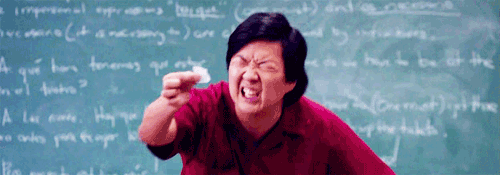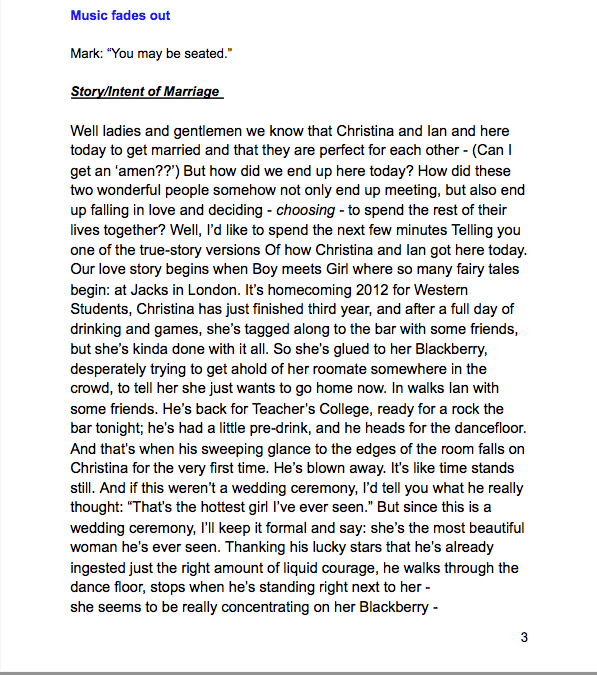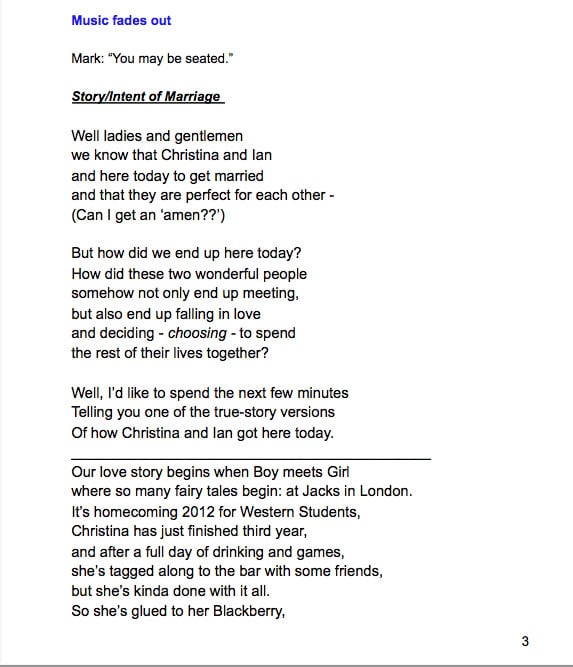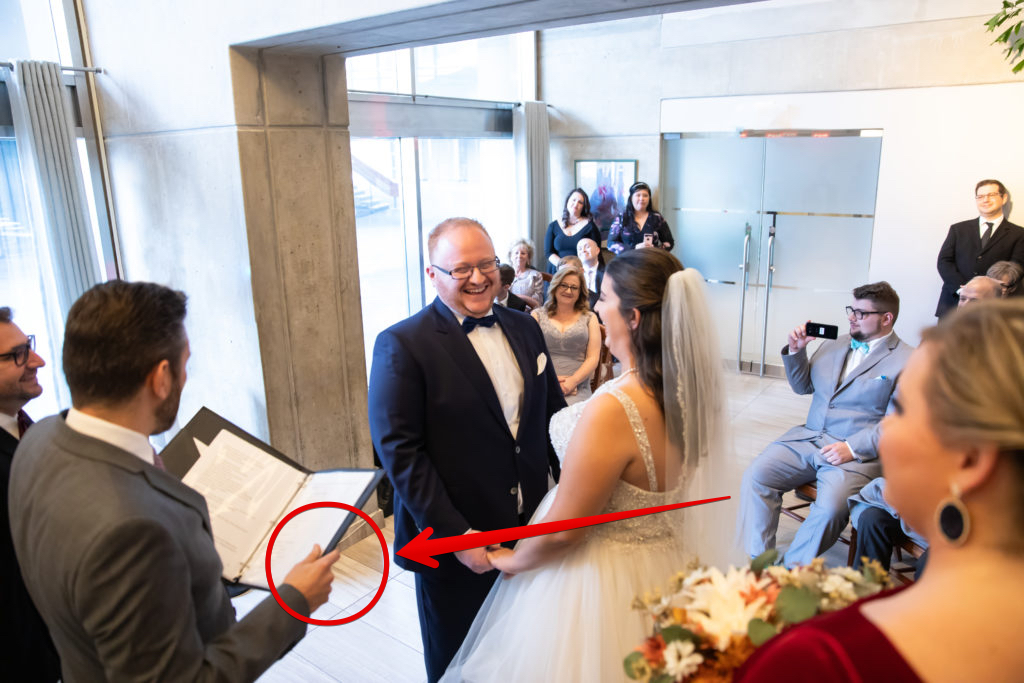I get asked at least once a week: How much of the wedding ceremony script can I read? Is it even okay to read it at all? How much of the script do I have to memorize?
I love being the bearer of good news, so here it is:
You can read absolutely all of the wedding ceremony script word-for-word.
As wedding officiants, we’re not Tony Robbins. We’re not motivational speakers. We don’t need to stalk the stage up and down and pace back and forth. Nobody expects that or wants that from us.
We need to think about officiating a wedding more like giving a presidential speech. Absolutely everything is pre-written. Every word.
And it gets read.
There are ways to read well, and ways to read badly.
A truly great orator reads the teleprompter or the paper script with a well-paced cadence and tempo. This allows her to look up comfortably, move her head side-to-side, and perhaps most importantly, stand tall.
Reading badly is the opposite of that. No need to go into it. We know bad reading when we see it.
As wedding officiants, we need to go all “truly great orator” style: read with a well-paced cadence and tempo. Look up frequently and comfortably at our couple and their guests. Move our heads freely. And stand tall (even if we’re not all that tall!).
Here are 3 crucial tips for reading your wedding ceremony script really well up there so you don’t look like, well… this:

1. Print your wedding ceremony script in a large font
We love default settings. And sometimes that means we never question them. And we certainly don’t think to change them! I mean, it’s the default for a reason, right?
The default font size in word-processing software like Word or Pages or Google Docs is usually 12 or even smaller.
A 12-point font is perfect when you’re printing a report, but it’s a big problem when you’re printing an officiant speech for a wedding.
The key to reading naturally is not having to stick your eye six inches from the page. It’s being able to glance down without moving your head down or moving the script up. It’s seeing the words clearly.
So the fix here is easy: use a bigger font than Word or Pages or Google Docs suggests. The number will vary depending on how you do on your eye chart exam. It will also be determined by what font you decide to use.
For me, the perfect font and size are Arial 14.
Why Arial 14?
Let me answer that by explaining this: getting the font and size right for you will do two things.
First, it will maximize how well you can see the words of your wedding ceremony script.
Second, it will minimize how often you have to turn the pages. You don’t want to be flipping paper like you’re cramming for a test up there.
The perfect font and size for you strike a balance between seeing the words easily and not having to flip pages too often.
For me, that perfect balance is Arial 14.
The perfect balance for you may take some experimentation. It might be Arial 14. It might be Helvetica 16. Just try to figure it out in your practice runs, not up there in front of the 200 people.
2. Break up your wedding officiant script into lines
Okay, so we’ve cleared the hurdle of needing a magnifying glass to read our script. Now it’s nice and big. But we’re not out of the woods yet. Because… so what if it’s big? If we keep losing our place on the page, then all the gains we make from an easy-to-see script are lost.
A script that’s easy to see is still not necessarily easy to read.
Now it’s time to make our script easy to read, too.
Wedding Ceremony Speech Examples
Let’s do a little exercise. Take a look at these two “Page 3s” from a wedding script I recently wrote. And get ready: I’m gonna ask you a question after you do.
Exhibit A:

Exhibit B:

Here’s my question: which of the two formats above will allow you to find your place on the page most easily? (Hint: only one of the pages is the one I actually used in the wedding.)
If you picked Exhibit B, you’re right! (Obvi.)
So many of us wedding officiants write our scripts in big block paragraphs of text! Why? Because that’s how we learned to write prose in school. (“Default mode” strikes again!) We feel weird writing in lines because… isn’t that reserved just for poetry?
Writing a wedding script that’s broken up into lines serves a crucial function. It allows us to feel comfortable looking up, looking around, smiling and laughing with whatever is happening at the moment with our couple, and getting back to reading. And then we’re not worried about losing our place! Because we know the last word that came out of our mouth, and we know where that last word is on the line and on the page.
So we’ve got a nice big font and we’ve got a script that’s broken up into lines. Print that out and put those 8.5″x11″ sheets into a classy slim 3-ring binder with sheet protectors. Now you’re ready to read this thing like a boss.
There’s just one more hack that seals the deal.
3. Never hold a microphone during the wedding ceremony (or: Do slide your thumb down the page)
In my coaching service for new officiants, I’m astounded at how many officiants plan to hold a microphone while they officiate. (It’s okay. We all make rookie mistakes.) I always ask them about their plans for a mic, and I strongly advise them against holding a mic.
With my own couples, I insist on being hands-free. I need a mic on a stand or a clip-on lapel mic. It’s the only thing I’m a diva about when it comes to officiating.
Why am I suddenly talking about microphones? Because it’s crucially relevant to the last hack to read the ceremony well:
Slide your thumb down the margin of the script while you read.
You can’t do that when you’re juggling your script and a microphone.
While I’m reading the wedding script, I’m supporting my binder with one hand and lightly grasping the edge of the binder with my other. No one would notice that I’m actually sliding my hand down the side with my thumb acting as a moving tab marker.
You can actually see this in action in a photo of me officiating a wedding at Toronto City Hall. (Thanks to Eric Benchimol for the photo!)

See how my hand is positioned? It looks perfectly natural, but that right thumb is telling me exactly where I am in the script. Which means I can look up and laugh right along with Shaun and Shannondoah and all their guests.
And that’s what we’re all looking for as wedding officiants: confidence and comfort in front of our couple and their wedding guests.
One of the best ways to achieve that? Formatting our wedding ceremony script so we can read well.
Recommended: Write the Perfect Wedding Ceremony Script

